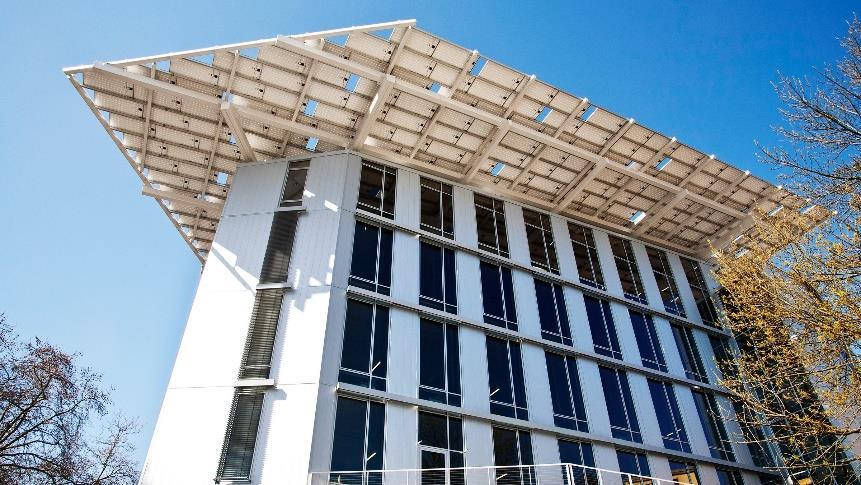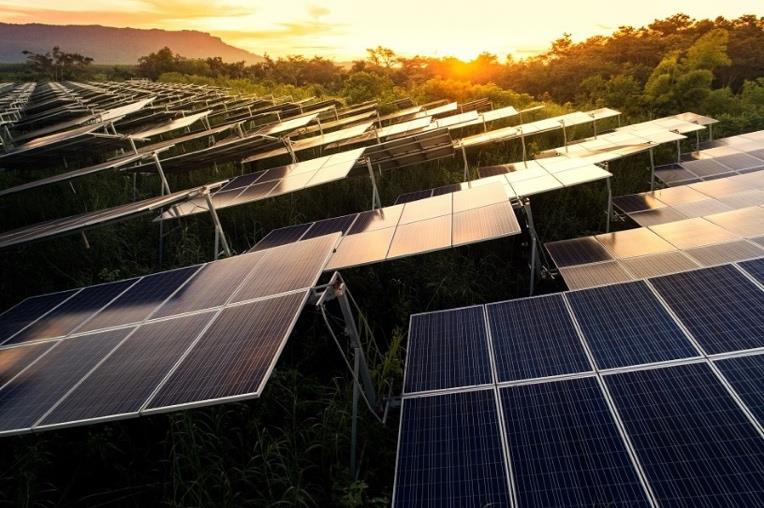

CHAIR
Tanya – Year 13
EDITORS
Sophia – Year 11
Mahi – Year 11
Anika – Year 12
Aiyana - Year 12
ILLUSTRATOR
Anoushka – Year 13
WRITERS
Vittoria – Year 8
Mahi – Year 11
Jasmine – Year 11
Aiyana - Year 12
Alice – Year 13
2
Contents
Decarbonising Construction: Designing Low Carbon and Sustainable Buildings
Vittoria – Year 8
Electric Planes: The Solution for The Future?
Mahi – Year 11
Hydrogen powered planes on the rise
Jasmine – Year 11
Can Space Exploration truly be sustainable?
Aiyana - Year 12
Nano-structured solar cells
Tanya – Year 13
Metamaterials – the materials of the future?
Alice – Year 13
3
Decarbonising Construction: Designing Low Carbon and Sustainable Buildings
 By Vittoria – Year 8
By Vittoria – Year 8
Architects have been looking for new and innovative ways to make buildings as eco-friendly as possible and to ensure a low-carbon footprint. One of the ways this has been done is by creating a building that acts just like a forest – it generates its own energy, absorbs locally available water, and produces no waste. In 2013, this building was constructed in Seattle, Washington, with its main aim being to mimic a forest of Douglas fir trees that previously occupied the area. This six-storey office building is 30 metres high, harvests all its water from rainfall, composts all its waste, and returns it back to the soil. It also has a treelike canopy on its roof that holds 575 solar panels allowing the building to be an energy supplier; the building creates about 30% more electricity than it uses.
These types of buildings are precisely what the world needs to help deal with climate change. Architects are continuously looking towards taking inspiration from nature and using it in making buildings eco-friendly, through the science of biomimicry.

Biomimicry is the act of imitating nature’s ecosystems, natural processes, and organisms as best as we can to solve human problems sustainably. Humans have always taken inspiration from nature, but the specific difference in this project is to reduce their carbon footprint and the 47% of carbon emissions created by buildings and materials.
Following nature and its processes has already been proven to be successful in many ways. Now, many more companies are realising this and are introducing eco-friendly and low carbon footprint designs to their ideas and inventions. This could be the start of a new way to reduce carbon emissions and perhaps stop or even reverse climate change.
References:
1. https://www.wired.co.uk/article/biomimetic-architecture?scrlybrkr=ba51e991
4
Electric Planes: The Solution for The Future?
 By Mahi – Year 11
By Mahi – Year 11
Whilst planes are usually associated with the exhilaration of a vacation, summer days spent tanning on the beach, and exploring the world, the aviation industry has a hidden dark side. The aeronautics industry contributes to 2.5% of global CO2 emissions, emitting approximately 800 billion tonnes (2022 figure) of carbon dioxide annually into the atmosphere. As the industry recovers from the Covid-19 pandemic, international travel demands are peaking. The increased demand for fuel has driven to a surge in carbon emissions, consequently leading to the search for more environmentally friendly travel alternatives. The solution: electric air travel.
Whilst commercial electric planes may seem futuristic, the first model could be out by 2026. This is a result of a technological push, which is driving manufacturers to develop an electric aircraft designed to support the consumers of the aviation industry and eradicate the need for carbon-based jet fuel. Like their vehicular equivalents, electric aircrafts have motors powered by lithium-ion batteries. When electrically charged, a chemical reaction occurs inside the battery which in turn causes lithium to release electrons, creating lithium ions. These then move from the anode of the battery to the cathode thus and moves the power along to the propeller. This reaction continues until all the electrons have reached the cathode, and the battery needs to be recharged using an external source to replace the used electrons and send them to the anode.
However, one of the main issues electric planes faces is the battery weight. This issue revolves around the fact that lithium-ion batteries simply do not offer the same amount of energy density as a fuel-powered engine can. Powering a commercial jet, especially for international and long-distance flights, would require several heavy batteries that would eventually comprise of 60% of the aircraft’s weight. This is compared to the 30% that jet fuel uses. This renders it unable to carry large numbers of passengers and consequently to fully switch to electric planes would be fatal for the airline as they would be unable to deal with the increasing number of passengers. Furthermore, electric planes require heavy amounts of new infrastructure. Like its automobile equivalents, electric planes need a powerful and efficient system to refuel, especially when considering the tight time schedule of a commercial airline. Currently, a standard aircraft takes 45 minutes to fully refuel and can run for up to 21 hours on a single tank. The amount of energy required to match this performance will likely exceed what the electrical infrastructure of existing airports can deliver. This means new infrastructure will have to be especially built for this purpose, requiring a significant financial investment that most airlines are unwilling or unable to spend. This ties in with the problem of the project management triangle (one out of cost, time and quality having to be compromised) for aircraft manufacturers designing electric planes. Furthermore, certifying a new aircraft for commercial use is an arduous process which can take 5 to 7 years to come to fruition, after going through numerous tests, approvals, and safety inspections.
5
Figure 1 – A visualisation of Alice, one of the leading prototypes for electric planes
Furthermore, the optics of new technology are always unpredictable. Introducing a new product to a new audience is always a risk: especially in the case of an airplane. Though airplanes are key to the world today, whether for cargo, commercial or private use, the risk of danger can be overwhelming. This can directly apply to new audiences, especially those who are worried about the safety of embarking on an aircraft based on new technology.
Although there are many challenges posed by the development of electric planes, it seems to be the future of the aviation industry. It is an eco-friendly alternative to today’s problems and has the potential to cut down the aviation industry’s carbon footprint and make it a more environmentally conscious business.
References:
1. Timperley J. Should we give up flying for the sake of the climate? BBC. Published February 19, 2020.
Accessed August 11, 2023. https://www.bbc.com/future/article/20200218-climate-change-how-to-cut-yourcarbon-emissions-whenflying
2. How Close Are We to Electric planes? www.aircharter.co.uk. Published April 21, 2022. https://www.aircharter.co.uk/about-us/news-features/blog/how-close-are-we-to-electric-planes
6
Hydrogen powered planes on the rise
By Jasmine – Year 11
An average of 5,989 UK flights took place every day of the week commencing 13th August 2023 – an 8% increase to the equivalent week of 2022. Every flight releases a huge quantity of carbon emissions into our atmosphere, and thus the increase of flights is resulting in catastrophic consequences for our environment. For example, a flight from London to San Francisco emits around 5.5 tonnes of carbon dioxide equivalent (CO2e) per person. This is more than twice the emissions a family car produces in a year. Even a flight from London to Berlin emits around 0.6 tonnes of CO2e – three times the emissions saved from a year of recycling.
Emissions from planes are rising rapidly. Between 2013 and 2018 they increased by 32%. Whilst improving fuel efficiency is gradually reducing the emissions per passenger, it is not keeping up with the rapid increase in total passenger numbers, which are estimated to double in the next 20 years.
Luckily, engineers such as Dale Vince are aiming to offer greener flying with zero-emission electric planes in only three years’ time. They have chosen to tackle this challenge by using hydrogen.
There are two main ways of using hydrogen to power zero-emission planes. The first way to power the engine is by burning hydrogen through gas turbine engines. The second way, which only releases water vapour, is to use hydrogen fuel cells on the plane. This converts the hydrogen into electricity, powering an electric motor, which in turn drives a propeller. ZeroAvia, Universal Hydrogen of California, and Australia’s Stralis are all using this method. Some companies, such as Airbus, are exploring a mixture of both technologies. Bob Criner, the co-founder of Stralis Aircraft, thinks that fuel cells are the preferable method because they have lower maintenance costs and no risk of contributing to climate change. He states that ‘combusting hydrogen eliminates CO2 emissions – however, it still produces other harmful emissions such as NOx, sulphates, particulates and soot.’
Although hydrogen is very light compared to batteries and can be stored as a gas or liquid, there are several challenges that engineers face with hydrogen-powered planes. Firstly, hydrogen must be stored at a very low temperature of -253°C, so efficient cooling systems are necessary. Secondly, hydrogen has a low energy density by volume, which makes it challenging to store in large quantities. Thirdly, in the hydrogen fuel cells, a catalyst is required to split the hydrogen into protons and electrons. This catalyst is typically platinum. However, platinum is very expensive, so scientists are looking at alternative materials.
To conclude, great progress has been made to prepare hydrogen-powered planes for take-off. For example, on 2nd March 2023, Universal Hydrogen successfully flew its Dash-8300 test aircraft powered by a hydrogen fuel cell. It took off from Grant County International Airport in Moses Lake, Washington, and flew for 15 minutes, reaching an altitude of 3,500 feet. The Dash 8, named Lightning McClean, became the largest aircraft yet to fly powered by a hydrogen fuel cell, following ZeroAvia’s first test flight on 19th January 2023 with Dornier 228, which also had a fuel cell. Universal Hydrogen plans to launch hydrogenpowered planes into commercial service around 2025 with small, local flights, and larger aircraft as soon as the mid-2030s. This will greatly reduce aviation’s carbon footprint. In the meantime, we should all endeavour to reduce how often we fly in order to lower our carbon footprint and thus save the planet.
References:
7
1. Economic activity and social change in the UK, real-time indicators - Office for National Statistics (ons.gov.uk)
2. Should we give up flying for the sake of the climate? - BBC Future
3. The Times newspaper, Saturday 22nd July 2023, article title: Are electric planes ready for take-off?
4. The cold heart that powers our ZEROe aircraft | Airbus
5. Is the Electric Plane Ready for Take Off | Eley Metrology
6. Are electric planes ready for takeoff? – DW – 01/24/2023
7. The 11th Breakthrough Technology of 2023 takes flight | MIT Technology Review
8. Universal Hydrogen Flies Hydrogen-Powered Dash 8 | FutureFlight
9. Universal Hydrogen flies hydrogen fuel cell aircraft | Aerospace Testing International
10. ZeroAvia flies largest hydrogen fuel cell powered aircraft yet | Aerospace Testing International
8
Can Space Exploration truly be sustainable?
 By Aiyana – Year 12
By Aiyana – Year 12
On the 21st of July 1969, Neil Armstrong became the first person to walk on the moon. Over 50 years later, on the 16th of November 2022, Artemis 1 launched: it saw the beginning of the mission which aims to establish a long-term presence on the moon and explore more of the lunar surface. This will come with increased levels of space travel, and numerous space exploration vehicles. Whilst this will pave the future for space exploration and deeply aid in the mission to bring humans to Mars, the question arises whether this can be done in a sustainable way. Technology has progressed greatly since the beginning of cosmic investigation, and through this, innovations have arisen that aim to ensure that space travel can be done in a sustainable manner that will truly benefit human existence.
Propellant fuel and materials utilised in the building of rockets and rovers can be detrimental to Earth’s –and space’s – environment and as such, green initiatives must be implemented in order to allow for continued space exploration.
Since the 1960s, innovations have been made to support the sustainability of space exploration, however headway is being made now more than ever.
One of the key factors that has boosted the path into justifiable space exploration has been the focus on making the regulations more stringent, relating not only to health and safety, but also to the environment, which will allow for a minimization, and eventual elimination, of harmful materials.
Another factor has been international pressure to enact changes for the benefit of Earth and the extended universe. A key example of this can be seen in NASA’s undertaking of a lead-free policy, despite it not being an enforced regulation. This is where innovation has become pertinent, as NASA has to search for and decide on novel solutions in order to ensure that these lead-free alternatives will function at the same level as their previous counterparts.
With numerous electronic components on the International Space Station and other vehicles, soldering is repeatedly used. Traditional solder is made from tin and lead, however after NASA undertook this Pb-free policy, it quickly became important that a replacement was found. SAC alloys (based on mixtures of tin, silver, and copper) are the primary choice and NASA conducted a ‘Lead-Free Experiment in a Space
9
The launch of Artemis 1 in November 2022
Environment.’ Here they discovered that this could be a successful alternative as the solder withstood all the different experimental levels. Even with malfunctions occurring that led to high temperatures being reached, the solder still withstood all these challenges.
Unfortunately, NASA has not accepted this as the new ‘norm’ due to the importance of solder and as it has no evidence yet of how the solder would last in space for an extended duration. However, with time, it is highly likely that NASA will adopt this effective alternative.
One field where NASA is yet to make a key breakthrough is in the fuel used for satellites and space exploration vehicles. There is a search for ‘green propellants’ that can be utilised as a replacement for the toxic hydrazine that is currently used as fuel. Hydrazine results in exceptionally large rocket emissions and is directly linked to ozone loss, a key indicator of its unsustainability, clearly demonstrating the need for an effective alternative. Alongside Hydrazine’s detriment to Earth, even in the short-term, exposure can cause dire health problems, increasing the need for an effective alternative. The Green Propellant Infusion Mission (GPIM), led by Ball Aerospace for NASA, aims to not only find a ‘green’ alternative, but also increase cost efficiency.
The desired substitute is a hydroxyl ammonium nitrate fuel/oxidizer blend, better known as AF-M315E. It has low toxicity and provides a 50% greater density-specific impulse than its previous counterpart. As a result, it is a highly favourable alternative as it is easier to store and is much safer. Due to the greater impulse, there is a potential for shorter launch processing times. As a newer alternative, it is not yet being used for satellites, space exploration vehicles or rockets, as all the necessary tests have not been completed. However, many tests have been undertaken that suggest this to be a promising substitute for the future.
Many advancements have been made within the world of space travel that suggest a positive future for this highly relevant industry. Although there are still many areas where space travel is not yet sustainable, there is a promise from advancements in other areas that suggests that, within a relatively short period of time, space travel will be able to become a truly sustainable field.
References:
1. https://ntrs.nasa.gov/api/citations/20080039268/downloads/20080039268.pdf
2.https://www.nasa.gov/centers/ames/greenspace/nasasrole.html#:~:text=From%20solar%20arrays%20and% 20fuel,and%20green%20technologies%20continue%20today
3. https://www.nasa.gov/content/green-engineering-initiatives
4. https://www.nasa.gov/mission_pages/tdm/green/index.html
5. https://ntrs.nasa.gov/api/citations/20170001286/downloads/20170001286.pdf
6. https://ntrs.nasa.gov/api/citations/20120013539/downloads/20120013539.pdf
7. https://agupubs.onlinelibrary.wiley.com/doi/full/10.1029/2003JD004370
10
Nano-structured solar cells
By Tanya – Year 13
Energy, in one way or another, is essential to life on this planet, with the most abundant and reliable source of energy being solar. As the world grapples with the urgent need to transition towards sustainable energy sources, the development of advanced solar cell technologies has become a priority to many scientists and researchers. Among the numerous innovations in this field, nanostructured solar cells have emerged as a promising solution.
Nano-structured solar cells represent a transition from traditional solar cell designs. The majority of solar cells use silicon as the semiconductor material, starting as thin wafers of crystalline silicon which are then processed to have the desired properties and characteristics to achieve effective sunlight conversion. The cells are then doped with specific impurities – usually phosphorous and boron – in order to create an electrical imbalance. This creates a p-n junction within the cell, essential for its function. Unlike typical solar cells, Nano-structured solar cells use nanomaterials that can be engineered to improve the performance of a solar power unit. Nanomaterials are materials with unique structures and properties that are on the nanometre scale (where one nanometre is the same as one-billionth of a meter.)
One considerable advantage of nano-structured solar cells is their ability to trap and absorb a greater amount of sunlight leading to a greater efficiency when converting sunlight to electricity. This is a result of them having a larger surface area to volume ratio due to their small size. Additionally, they can be modified to have more than one light absorption path allowing the photons to take different routes through the material, increasing the chances of absorption.
Nano-structured materials can also be made more lightweight, flexible, and adaptable. This means that there might be possibilities of solar panels for curved surfaces and integrations of this into numerous materials. Additionally, nanotechnology allows tandem solar cells (in which many layers of cells can be stacked) to have different energy bandgaps. Finally, some materials that may be used in solar cells are low cost, such as quantum dots and perovskite. Quantum dots are semiconductor particles a few nanometres in size, that can be tuned to absorb specific wavelengths of light, improving its sensitivity. This affordability opens solar energy to a broader range of consumers and can improve implementation of solar energy. Perovskite material solar cells have optimal light-absorbing properties and can be used in tandem with traditional silicon solar cells for high efficiency.
Although they offer great promise, nano-structured solar cells face several challenges. These include long term performance and stability issues, which researchers are working to fix. In the future, we can expect nano-structured solar cells to play a crucial role in the complete adoption of renewable energy and its integration into society.

11
References:
1. Nanografi Nano Technology. (n.d.). Nanostructured Solar Cells. [online] Available at: https://nanografi.com/blog/nanostructured-solar-cells/
2. Das, N. (2017). Nanostructured Solar Cells. BoD – Books on Demand. Available at: https://www.intechopen.com/chapters/54030
3. Beard, M.C., Luther, J.M. and Nozik, A.J. (2014). The promise and challenge of nanostructured solar cells. Nature Nanotechnology, 9(12), pp.951–954.
12
Metamaterials – the materials of the future?
By Alice – Year 13
From wide range wireless charging to the creation of invisibility cloaks, it seems that metamaterials are truly materials of the future, allowing us to manipulate waves and fields. But what makes metamaterials so special?
The definition of metamaterials provides us with an answer - they are artificial materials with properties that go beyond (meta) what we have observed from natural materials, namely how they seem to act ‘oppositely’ to what we expect conventional materials to behave. What is amazing about them is they have been engineered to act in a way that does not exist naturally, which is a demonstration of innovation in itself (just like superconductors).
Negative index metamaterials (NIM), or left-handed (LH) materials, exhibit some interesting phenomena when interacting with light (or other EM waves).
https://www.scientificamerican.com/article/engineered-metamaterials-can-trick-light-and-sound-into-mind-bending-behavior/
Negative refractive materials (NRM) have been regarded as a material with much potential in photonics, with Pendry proposing the production of a perfect lens (superlens), which may be able to focus light onto an area greater than that of a square wavelength, which is the current limit in wave optics.
https://journals.aps.org/prl/pdf/10.1103/PhysRevLett.85.3966This is due to a mathematical proof he conducted, which concluded that a hypothetical NRM slab would be able to amplify and restore evanescent waves (reflected waves which decay exponentially rather than propagate energy sinusoidally)

13
https://en.m.wikiversity.org/wiki/File:FocusPerfectLens.jpg
This could potentially lead to better imaging quality, which was what led to scientific discoveries in the past and will lead to new innovations in the future which could help with further progress in the fields of biology and physics.
Although there are limitations in the conditions for “perfect imaging” in terms of the feasible wavelengths super-lenses can currently use, metamaterials most definitely may be considered as materials for the future.
References:
1. https://journals.aps.org/prl/pdf/10.1103/PhysRevLett.85.3966
2. https://www.andrew.cmu.edu/user/dcprieve/Evanescent%20waves.htm
3. https://www.scientificamerican.com/article/engineered-metamaterials-can-trick-light-and-sound-into
4. mind-bending-behavior/ https://en.m.wikiversity.org/wiki/File:FocusPerfectLens.jpg

14



 By Vittoria – Year 8
By Vittoria – Year 8

 By Mahi – Year 11
By Mahi – Year 11
 By Aiyana – Year 12
By Aiyana – Year 12


